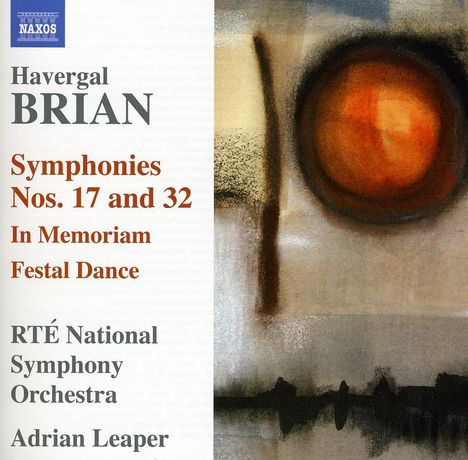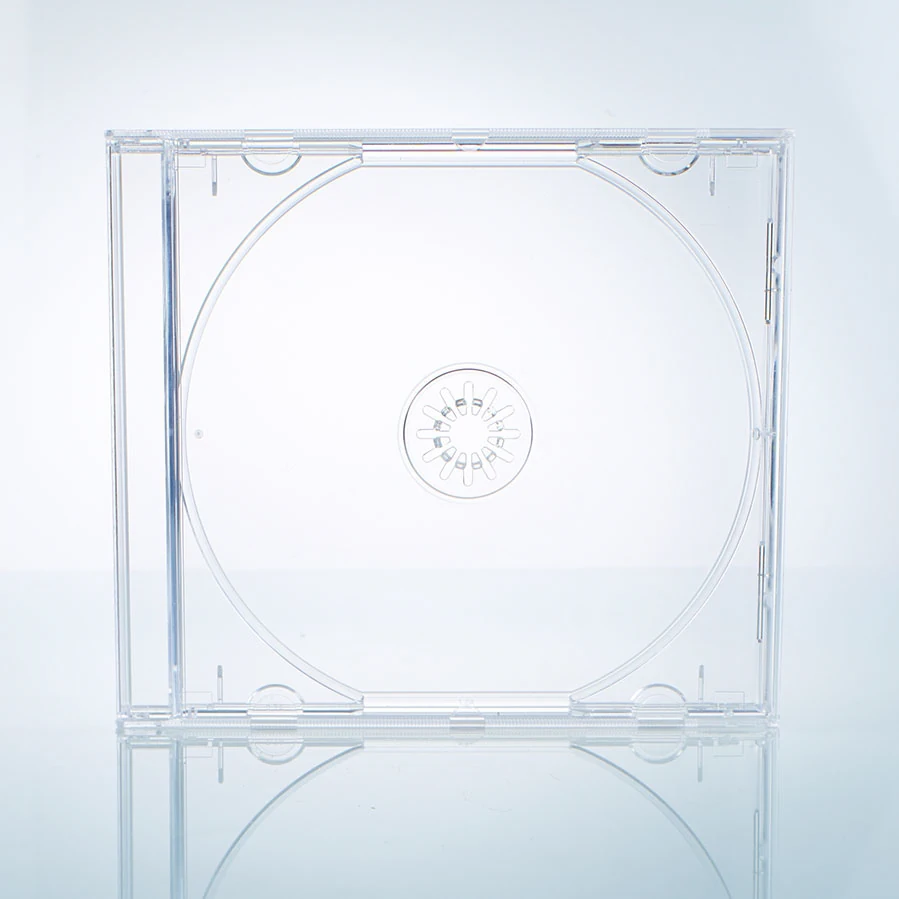Havergal Brian: Symphonien Nr.17 & 32 auf CD
Symphonien Nr.17 & 32
Herkömmliche CD, die mit allen CD-Playern und Computerlaufwerken, aber auch mit den meisten SACD- oder Multiplayern abspielbar ist.
(soweit verfügbar beim Lieferanten)
+In Memoriam; Festal Dance
- Künstler:
- RTE National SO, Adrian Leaper
- Label:
- Naxos
- Aufnahmejahr ca.:
- 1992
- Artikelnummer:
- 4981386
- UPC/EAN:
- 0747313202072
- Erscheinungstermin:
- 29.11.2010
Von den 32 Sinfonien des englischen Komponisten Havergal Brian ist –wenn überhaupt –nur seine gigantische Erste, die sogenannte Gothische, bekannt. Die übrigen Sinfonien Brians wurden bedauerlicherweise über Jahrzehnte vergessen und finden erst allmählich öffentlich Gehör. Auf der vorliegenden CD begegnen die fantasieartige Sinfonie Nr. 17 und die fast trotzig affirmativen Nr. 32 zwei ebenso kontrastreichen Sinfonischen Dichtungen – enigmatisch in der Atmosphäre klingt In Memoriam, überschwänglich und kaum zu bändigen ist der Festal Dance.
Havergal Brian was a very long-lived composer: his creative career, begun in the 1890s, continued into the late 1960s. The works on this recording, from the early and late portions of that career, span sixty years, from 1908 to 1968.
The symphonic poem In Memoriam was composed at Trentham, Stoke-on-Trent, in 1910 and completed on 27 October of that year. Essentially an extended symphonic study in the slow-march rhythms which fascinated the composer throughout his career, in the context of Brian’s early achievement it is a major work. Although published in 1913, In Memoriam was only twice performed in his lifetime (a pair of performances by the Scottish Orchestra under Sir Landon Ronald in Edinburgh and Glasgow on 26th and 27 December 1921 respectively), and then probably slightly cut. Brian seldom referred to the work, or gave any clue as to its inspiration. He did, however, deny that In Memoriam had any connection with Tennyson’s poem of the same name, or that it commemorated King Edward VII (who died on 6 May 1910), despite an apparent echo of the National Anthem in the central section.
The manuscript deepens the mysteries. On the spine of the cover, in gold lettering, stands the title Vigueur de dessus (rather curious French, possibly intended to mean ‘Utmost Strength’)—which appears nowhere on the manuscript itself; and on the first page is the cancelled subtitle Homage to an Artist. (If a particular artist is being celebrated here there is a slight chance it was the noted Potteries musician James Whewall, founder of the North Staffordshire District Choral Society, who was a friend and mentor to Brian throughout the decade up to Whewall’s sudden death in November 1909—just after he had crowned his career by conducting a concert with his singers before the King and Queen at Windsor Castle.) The manuscript also shows signs of an erased programme, apparently the depiction of a funeral ceremony. The only evidence of this to survive into the printed score is the division of the symphonic poem into three ‘Scenes’, played without a break.
The first Scene [1] has a six-bar introduction (headed Invocation in the manuscript), starting with a funeral-march rhythm in solo timpani and swelling out to introduce most of the orchestra (a large one, with triple woodwind, two harps, and organ). This is the first example of a species of opening Brian was to use in several of his symphonies, such as Nos. 8, 10, and 13. This initial rhythm, and the nagging triplet figures which immediately develop from it, have an important secondary rôle to play in the unfolding structure.
The first Scene proper, marked Lento (e con molto espressione) is built around a grave and noble march-tune, rather Elgarian in tone, announced by violas and clarinet, and a number of subsidiary figures of which the most prominent is the peremptory horn motif that follows immediately on the first statement of the melody. The various elements—most of them sharing a basic rising-falling shape—are treated to an extensive development, frequently involving veritable explosions of orchestral lamentation, though there are quieter, more intimate passages notable for their sensitive scoring. Brian manifests an impressive ability to construct substantial paragraphs on the ostinato-repetition of various of the subsidiary figures.
After a huge climax, the music gives way to the Second Scene [2], Andante ma solenne e religioso. In the manuscript this was in fact designated ‘Religious Scene’, and it begins quietly in muted strings—the four-part texture carries a hint of choral singing—with an extended theme which appears to quote from the National Anthem. While the principal tonality of the First Scene was C, that of the Second is E major. As it develops, with some faster episodes, this music embraces the most impressionistic orchestration in the whole work, with multi-divided string textures and imaginative use of the harps, eventually heard in consort with the organ. The episode works up to a scintillating, apparently triumphant, climax, only to be stopped in its tracks by a thunderous tutti restatement of the opening march-tune.
This returns us to C major and ushers in the Lento Third Scene [3]: much shorter than its predecessors, with something of the character of an epilogue. Fragments from the First Scene reappear in transparent scoring, before a final climax based on the march-tune (in which horns and cellos are urged to ‘exult’). A very quiet, peaceful coda appears to be veering towards the E major of the Second Scene, but In Memoriam contrives to expire in C with a distant breath of horns and a soft cymbal-stroke.
In strong contrast to In Memoriam stands Festal Dance, composed two years earlier—one of the two surviving portions of an early multi-movement work which Brian originally entitled A Fantastic Symphony. Practically speaking, this was his real ‘Symphony No. 1’; but it did not survive as a complete entity for more than a couple of years, and The Gothic (Naxos 8.557418–19) now stands as the official First. The Fantastic was a satirical, quasi-programmatic symphony (possibly inspired by the example of Richard Strauss’s Sinfonia Domestica), erecting a large-scale, virtuosic orchestral structure on the basis of the tune and tale of the well-known nursery rhyme Three Blind Mice.
Many details of the work remain matters for conjecture, but it is clear that the Fantastic Symphony was composed in 1907–8, probably in four movements with a scherzo and slow movement. By July 1909 Brian had recast it into a three-movement work, Humorous Legend on Three Blind Mice, with only a central scherzo (whether the music itself was revised at this stage remains obscure). Some time later he dropped the scherzo and decided to keep the first and last movements as separate works: the former became Fantastic Variations on an Old Rhyme while the finale—previously entitled Dance of the Farmer’s Wife—was renamed Festal Dance. There is some evidence that both scores were revised in 1912, prior to publication; but the surviving manuscript of Festal Dance, though corresponding to the printed version, still bears the original date of completion: ‘Stoke on Trent, Aug. 5th 1908’. First performed in Birmingham by Brian’s great friend Granville Bantock on 14 December 1914, Festal Dance was next heard at a Promenade Concert in the Royal Albert Hall during June 1915, under Sir Thomas Beecham, and was played several times in the inter-War period under Bantock and Sir Henry Wood (who featured it in two further Prom seasons, in 1920 and 1935).
Despite its original function as a symphonic finale, Festal Dance is in a ternary scherzo form, and is notable for the ‘advanced’ nature of Brian’s scoring, particularly the use of the percussion ensemble. Although there are Straussian aspects to this, the general orchestral style is very different, its fierce abandon suggesting affinities perhaps with the works which Prokofiev was to write over a decade later, such as the ballet Chout. The very opening, Allegro vivo [4], displays a bold use of the percussion alone (anticipating by some years Stravinsky’s Soldier’s Tale). The percussion establish the basic 3 / 4 rhythm on which virtually the entire work is built, and the orchestra immediately erects upon it a pounding E major idea (which foreshadows, by many years, the scherzo of Brian’s Third Symphony). Out of this opening subject Brian derives a more flowing Grazioso tune, first heard in the woodwind against a quickly marching quaver pulse in pizzicato strings (a ‘pre-echo’ of an important figure in the first movement of The Gothic). The Grazioso music grows freely, modulating swiftly through many keys and colours while the initial rhythm surfaces occasionally in the timpani. The excitement and the dynamic level increase in an extended development, the tune going into majestic canon before the opening subject returns explosively to the scene, only to be replaced by a Misterioso central section in C major [5] (the alternation of tonalities, E–C, is the exact reverse of the situation in In Memoriam).
This is a fugue. Brian had already composed choral fugues, but this, his first orchestral one, is gloriously unorthodox. Based on a deliberately rather galumphing subject, it begins very quietly on cellos and basses but rapidly develops into a new display of orchestral pyrotechnics. Brian’s sovereign disregard of mere transition-passages is already evident: rather than complete its form the fugue modulates back towards E and gives way abruptly to a curtailed return of the Allegro vivo music and the Grazioso tune, whose canonic form now introduces an extended coda. This is concerned with a variant of the basic 3 / 4 rhythm, tutti statements of which are interrupted by fierce, dissonant horn-blasts before a culmination of Dionysiac triumph. If this is the Farmer’s Wife dancing, one sees why the mice never stood a chance.
Five decades and a radical metamorphosis of musical language separate Festal Dance and In Memoriam from Brian’s Symphony No. 17, composed at Shoreham-by-Sea, Sussex, in the last months of 1960 and completed in early January 1961. During the twelve months preceding his work on this symphony he had written four others, Nos. 13–16, each in a single movement on a comparatively large scale and calling for large orchestral forces. No. 17, also in one movement, marked a change of emphasis towards a relatively smaller scale and an orchestra of more orthodox size—though Brian retains a large percussion body and pairs the tuba with a euphonium. It is also the most compressed and allusive symphony he had written since No. 12 in 1957 (Naxos 8.570308), and almost alarmingly fluid in its formal processes. In contrast to its immediate predecessor, the heroic Symphony No. 16 (1960), No. 17—a symphony not so much ‘in’ the key of C minor as orbiting around it—is one of Brian’s most abstract and elliptical utterances: there are fleeting hints of Romantic imagery and mysterious hymnody, but in general it might best be considered as a species of polyphonic fantasia in several clearly-defined sections, a kind of orchestral equivalent (though entirely different in language) to the big keyboard toccatas of Bach, which Brian much admired.
At the age of nearly 85, he had much to say, but said it tersely, in a swiftly-moving train of thought. Development is continuous, multitudinous contrasts of mood and texture following each other with sometimes bewildering rapidity. Nevertheless, the symphony’s single movement falls into three well-defined spans each with its own thematic material, the whole preceded by an Adagio introduction [6] whose principal ingredients of solo violin and horns in group harmony tinge the opening music with a Celtic romanticism. The irruption of timpani and bass drum prove this to be illusory: the first main section, Allegro moderato, concentrates instead on strenuous and sometimes martial contrapuntal activity set against a calmer, more flowing secondary theme. This volatile, continuously changing music shows Brian’s powers of sheer spontaneous invention working at full pitch.
A gentler transition passage, bringing back the solo violin, prepares the way for the Lento second section [7]. This, too, contains abrupt contrasts, but spaced out in more static fashion, slow-march motifs alternating with calm homophony and mysterious wind-instrument solos. A climax in march rhythm is soon succeeded by a curious whirling music for woodwind and full percussion, which introduces the symphony’s final section. This [8] begins Allegro con brio as a kind of highly contrapuntal symphonic waltz. To some extent this is a transformation of the motifs of the previous section. Soon, however, the music begins to deconstruct itself, progressively simplifying its textures and material, and before long it makes way for a massive Adagio coda—a choleric outburst, deploying the full power of the orchestra in Brian’s characteristic slow-march style, which makes a highly impressive conclusion to one of his least orthodox symphonic designs.
The Symphony No. 32 in A flat, Brian’s last and indeed the last work of any kind that he completed, is superficially far more orthodox in layout, in four movements with a slow movement and scherzo placed second and third respectively. However, the last two movements play without a break and the overall effect is rather of a structure in two large halves, the first moderately-paced and brooding, the second fast and energetic. Brian composed this symphony in his final home, a council flat overlooking Shoreham Beach, at the age of 92. It does not seem designed as a testament or summing-up—he had another four years to live, and the fact that he wrote no further works seems partly due to problems with his eyesight and to a final drying-up of inspiration. ‘It is the last I do believe’, he wrote to a friend just after his 93rd birthday, ‘for I’ve had no thoughts of music since and have enjoyed and still enjoy silence’. Nevertheless, in the way it continues to explore Brian’s inner world and find new landscapes of the mind, and in its characteristic compound of dark, difficult thoughts and defiant affirmation, Symphony No. 32 in the same key as the First Symphony of Brian’s lifelong hero Elgar—represents a satisfying termination of his creative output.
Despite its tempo-marking Allegretto, the first movement [9] is an introspective polyphonic invention which bears some resemblances to a sonata form. The real contrasts here, however, are between the gaunt and jagged lines of the opening complex of ideas and the more smoothly flowing and confident music which occupies much of the place of the development. A compressed recapitulation of the initial materials brings an irascible climactic coda with part-writing of extraordinary, almost uncouth harshness, with a sudden quiet cadence to finish.
The Adagio slow movement [10], one of the profoundest inventions of the composer’s last years, begins with drifting fragments of themes which are slowly welded into a purposeful motion, gathering power and impressiveness until we encounter the very last of Brian’s funeral marches. This rises in three great waves of sound, the material continually developing and metamorphosing, eventually blotted out in an angry roar of sound. After a pause, a brief coda ends the movement in a similarly drifting, enigmatic mood to that in which it began.
The second half of the symphony is a deliberate foil to the first, rejecting its oppressive brooding in favour of a energy and sane but not shallow optimism. It begins with a vigorous scherzo, Allegro ma non troppo [11], in a loping 6 / 8 metre. At its centre is no formal trio but a lightly-scored and dancing music, for alternating groups of solo woodwind and strings. The main scherzo music returns in fuller orchestration and develops new offshoots, then a slower, lyrical coda leads straight into the finale, Allegro moderato. This [12] is an open-ended, continuously-evolving structure whose ceaseless flow of freely-developing polyphony has a vivacity altogether remarkable in a man of 92. The thematic focus is the pair of ideas announced in its opening bars: a rising four-note figure in even crotchets and a descending semiquaver sequence. But these simple ingredients give rise to a seamless and virtuosic display of contrapuntal high spirits which endorses Brian’s oft-repeated conviction that (as he wrote in 1932) ‘the greatest of modern composers are those who have shown the greatest talent in continuous contrapuntal writing’. A brass fanfare, finally emerging from the sustained welter of activity, leads to a broad and noble cadential coda, triumphantly confirming the overall authority of A flat.
Malcolm MacDonald
Disk 1 von 1 (CD)
-
1 In memoriam: Introduction - First Scene
-
2 In memoriam: Second Scene
-
3 In memoriam: Third Scene
-
4 Festal Dance: Allegro vivo
-
5 Festal Dance: Misterioso
-
6 Symphony No. 17: Adagio - Allegro moderato
-
7 Symphony No. 17: Lento
-
8 Symphony No. 17: Allegro con brio
-
9 Symphony No. 32: I. Allegretto
-
10 Symphony No. 32: II. Adagio
-
11 Symphony No. 32: Iii. Allegro Ma Non Troppo
-
12 Symphony No. 32: IV. Allegro moderato
Mehr von Havergal Brian







